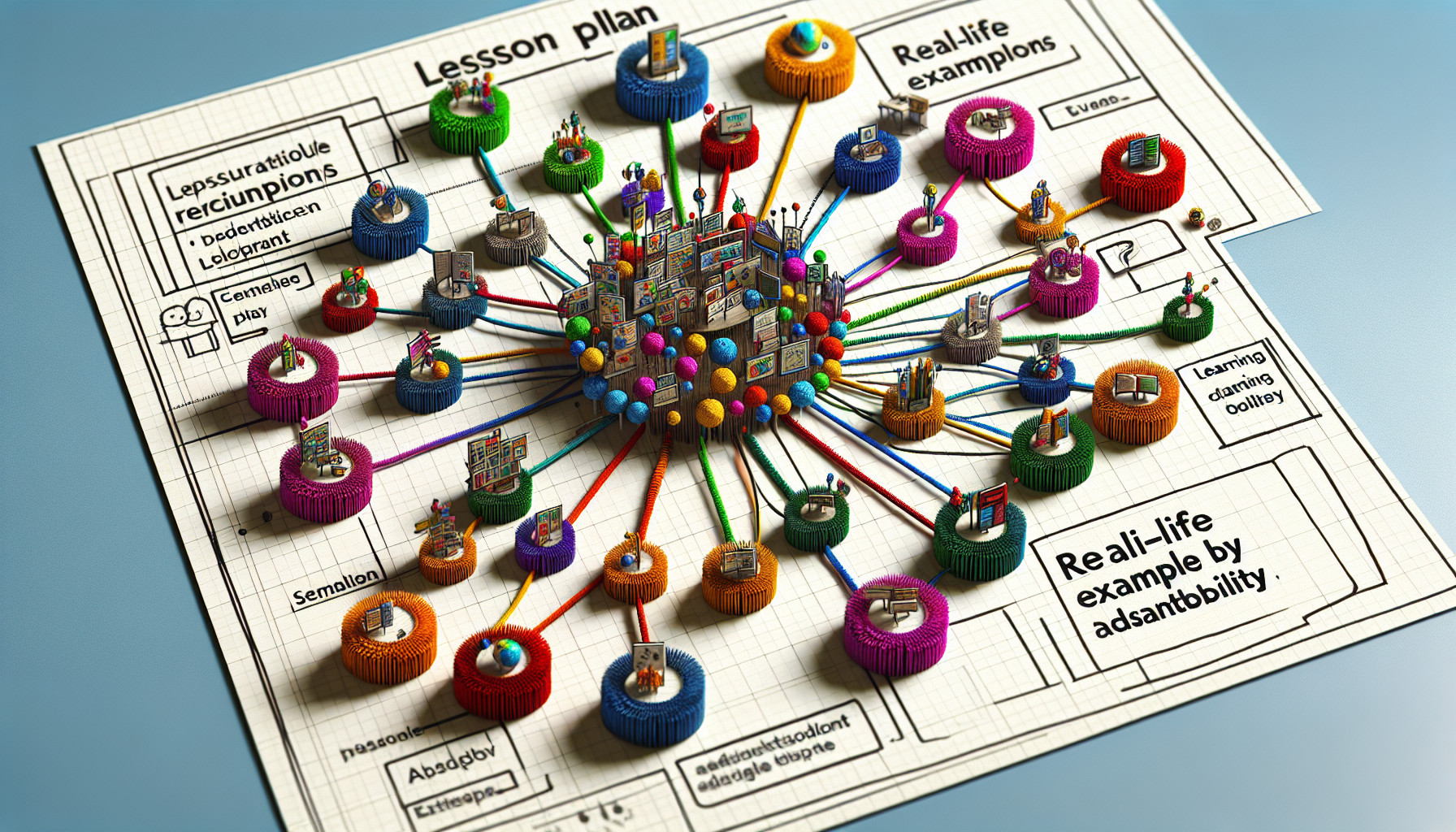Need a practical approach to the planning of teaching? You’ve found it. This article cuts through the clutter to deliver concise strategies for engaging and effective lesson planning. Discover how to develop clear, adaptable plans that respond to real-time classroom dynamics, align with educational standards, and captivate your students. Get straight into the building blocks of structured lesson planning and achieve the results you aim for without wasting a word.
Key Takeaways
Effective lesson planning involves clear learning objectives, structured flow, real-life examples, and engaging, appropriate activities tailored to diverse learning styles, using models like the 5E and Universal Design for Learning.
Engaging students is critical and can be facilitated through the use of multimedia, explicit communication of objectives, and fostering classroom interaction to create an absorbing and collaborative learning environment.
Preparation, real-time feedback, and post-lesson reflection are essential for successful teaching, enabling educators to adapt and refine their methods to align with curriculum standards and institutional frameworks for continual improvement.
Crafting Your Lesson Blueprint

Envision a lesson as a voyage, where a well-crafted plan is the compass guiding the way. A successful lesson plan addresses the dynamic classroom environment with precision, ensuring every teaching moment is harnessed to its full potential. By incorporating prioritized learning objectives, a structured lesson flow, and selecting appropriate learning activities, educators create a learning experience that resonates with students and stays adaptable to the ever-changing educational landscape.
Real-life examples bridge the gap between theory and practice, cementing the lesson’s relevance and enhancing student engagement. By incorporating relevant real life examples, this blueprint, akin to an instructor’s road map, orchestrates content and classroom dynamics for a productive lesson.
Identifying Learning Objectives
In the realm of lesson planning, identifying successful learning objectives is the cornerstone of a robust educational framework. By utilizing Bloom’s Taxonomy and the Backward Design model, educators can craft a ladder of ten learning objectives that support students in climbing towards a pinnacle of deep understanding and critical thinking. Successful lesson plans are rooted in clear learning outcomes and inclusive strategies that respect varied learning styles and student backgrounds, thus ensuring every student’s journey is acknowledged and supported.
As an instructor’s road map, learning objectives serve as beacons, guiding towards the desired learning destination, while also aligning with the broader educational compass—the national curriculum.
Structuring the Lesson Flow
A lesson is akin to a symphony, where each section flows seamlessly into the next, creating a harmonious learning experience. Engaging the students’ prior knowledge serves as the prelude, setting the stage for new concepts to be introduced and explored. With the infusion of AI-enhanced multimedia, educators can tailor the lesson flow to meet individual learning styles, offering personalized educational paths that resonate deeply with each student.
A captivating introduction, whether through a thought-provoking question or a relatable anecdote, can pique curiosity and set the tone for a particular lesson.
Selecting Appropriate Learning Activities
When orchestrating a particular lesson, the selection of specific learning activities is pivotal in achieving the teaching goals. These activities must not only engage students but also serve as a conduit for applying knowledge and obtaining feedback. In this pursuit, frameworks like the 5E model and Universal Design for Learning offer a palette of options to cater to different learning styles, ensuring that each student finds a resonance with the material presented.
By incorporating activities that challenge and excite, such as:
interactive eLearning elements
hands-on experiments
group discussions and debates
real-world simulations
Educators, through educational research, empower students to take ownership of their learning journey, fostering a sense of investment and curiosity.
The Art of Engaging Students

The artistry of engaging students in the learning process is akin to that of a conductor leading an orchestra. Each student plays a unique instrument, contributing to the symphony of the classroom. Through interactive elements that encourage critical thinking and active participation, educators can foster an environment where students are deeply involved in their education.
Real-life applications of concepts underscore the relevance and importance of the lesson content, captivating students’ focus and motivating them to explore further. A clear communication of learning objectives and expectations keeps students attuned and on task, making each educational interaction an opportunity for growth and discovery.
Using Multimedia and Visual Aids

In a world where digital media is omnipresent, leveraging multimedia and visual aids in teaching connects the dots between traditional education and students’ everyday experiences. Some benefits of using multimedia and visual aids in teaching include:
Catering to diverse learning preferences
Fostering collaboration and creative problem-solving
Enhancing engagement and motivation
Providing real-world examples and applications
By incorporating dynamic videos, animations, and group activities, educators can create a more interactive and effective learning environment.
These tools transform the classroom into an interactive stage where students can experience the joy of learning in a manner that resonates with their learning styles and enhances their long-term memory.
Encouraging Classroom Interaction
Fostering classroom interaction is not just about facilitating dialogue; it’s about creating a space where students feel empowered to share their thoughts and build on each other’s ideas. Group work and collaborative projects break the monotony of solitary learning, providing a fertile ground for diverse perspectives and collective intelligence to flourish.
A supportive environment, where active listening and personal engagement are the norms, encourages students to voice their questions and insights, thereby enriching the learning experience for all.
Telling Students Explicitly What to Learn
Clarity is key in a classroom setting. By telling students explicitly what they are expected to learn, educators set a clear path for the lesson’s journey. Goals and objectives become the guiding stars that keep students oriented, reducing confusion and enhancing overall engagement.
Framing learning objectives as key questions can spark curiosity and drive discussion, making the learning process an interactive and dynamic adventure.
Preparing for Success: Before the Lesson

The adage “success is where preparation and opportunity meet” resonates profoundly when it comes to lesson delivery. Before setting foot in the classroom, educators lay the groundwork for a successful teaching experience by creating a realistic timeline and preparing lesson materials, ensuring every minute of class time is optimized for student learning and engagement.
Anticipating student questions and considering their prior knowledge enables teachers to facilitate a learning experience that is both seamless and comprehensive.
Gathering and Organizing Lesson Materials
The organization of lesson materials can be likened to the preparation of a painter’s palette before the creation of a masterpiece. Teacher trolleys and digital resource management strategies are akin to the artist’s tools, enabling educators to streamline their workflow and focus on the art of teaching.
A consistent filing system and well-organized digital resources mean that the right materials are always at hand, saving precious time and allowing for a smooth transition between activities.
Anticipating Student Questions
Understanding the intricate tapestry of students’ prior knowledge is essential for educators to weave new concepts into their existing understanding. By anticipating the questions students may ask, teachers can tailor their lesson to address these queries proactively, thus fostering a deeper and more meaningful engagement with the subject matter.
During the Lesson: Strategies for Effective Delivery
Just as a pilot navigates through the skies, educators navigate the classroom with strategies that ensure the lesson’s message is delivered effectively. Organizing class time meaningfully and checking for student understanding in real-time are practices that underpin the success of a lesson, ensuring that teaching goals are met and learning outcomes are achieved.
These strategies not only reinforce the learning objectives but also enable educators to develop strategies and adapt their approach based on the immediate feedback and engagement level of their students.
Presenting the Key Points

In every lesson, certain key points act as pillars supporting the structure of learning. Presenting these points effectively is crucial, and doing so with positive reinforcement builds students’ confidence in their understanding of the material. Like a beacon in the fog, these key points illuminate the path for students, guiding them towards the learning outcomes set at the journey’s beginning.
Managing Class Time Effectively
Time, the most finite of resources in a classroom, demands careful management to maximize learning. Employing time management techniques and maintaining flexibility ensures that each lesson component receives the attention it deserves, adapting as necessary to the rhythms of the classroom.
By setting clear goals and breaking down tasks, teachers can steer the lesson forward, ensuring that every moment is an opportunity for student growth.
Obtaining Feedback in Real-Time
The classroom is a dynamic ecosystem, where real-time feedback is the pulse that measures the health of the learning environment. By observing student reactions and addressing concerns as they arise, educators can make informed adjustments to their teaching, ensuring that each lesson resonates with their audience. Such reflective practice is a hallmark of experienced teachers who are committed to constantly refining their craft.
Post-Lesson Reflection and Improvement
The echoes of a lesson delivered linger long after students have left the classroom, providing a canvas for educators to reflect upon their practice. This reflective practice is an integral part of the teaching process, allowing educators to assimilate feedback, contemplate new methodologies, and apply these insights to future lessons.
It is through this continuous process of self-assessment and improvement that teaching evolves into an art form, ever adapting and refining itself to meet the needs of its audience.
Reviewing What Worked and What Didn’t
Reflection is the lens through which educators can focus on their teaching methods’ effectiveness. By reviewing each lesson’s successes and noting areas for improvement, teachers can sharpen their educational strategies, ensuring that future lessons are even more impactful. This process of introspection is not only a tool for personal growth but also a commitment to providing students with the best possible learning experience.
Adjusting Future Lesson Plans
Armed with the insights gleaned from reflection, educators can sculpt their future lesson plans by considering their previous lesson plans and adjusting them to better fit the contours of their students’ learning needs. Adjustments made to lesson plans can range from simplifying complex concepts to integrating more group work, all in the pursuit of optimizing engagement and comprehension.
It’s through this iterative process that teaching becomes a craft, meticulously honed with each new lesson.
Integrating Standards and Curriculum Requirements
As architects of education, teachers must ensure that their lesson plans not only meet the immediate needs of their students but also align with the broader frameworks set by national and institutional standards. Integrating these standards into the curriculum fortifies the foundation of education, providing clear benchmarks for assessing teaching effectiveness and guiding the continuous improvement of educational practices.
Aligning with National Curriculum
The national curriculum serves as a blueprint, providing the structural integrity upon which individual lesson plans are constructed. By aligning lesson goals and objectives with national standards, educators can ensure that their students are building the skills and knowledge required for success in a standardized educational landscape.
Simplifying these objectives into language that is accessible to students enhances understanding and engagement, making the national curriculum not just a mandate but a meaningful part of the learning journey.
Adapting to Institutional Frameworks
Institutional frameworks, such as the Ofsted framework, act as compasses guiding schools towards quality education. Lesson plans crafted with these frameworks in mind demonstrate a commitment to excellence and a readiness to adapt to the rigorous standards set by educational oversight bodies.
By designing lesson plans that are flexible and responsive to these frameworks, educators can navigate the inspection processes with confidence, ensuring that their teaching not only meets but exceeds expectations.
Summary
In the symphony of education, each lesson is a movement that contributes to the grand composition of a student’s learning journey. Through meticulous planning, engaging delivery, and reflective practice, educators can craft experiences that resonate long after the final bell. As we close the curtains on our exploration of effective teaching strategies, let us carry forward the melody of these insights and continue to compose lessons that inspire, challenge, and transform.
Frequently Asked Questions
How do you write a teacher plan?
To write a teacher plan, start by identifying the learning objectives, planning activities, gathering materials, detailing the lesson plan, organizing the content, and considering any homework. These steps are essential for creating an effective teacher plan.
How do I ensure my lesson plans are inclusive and cater to all students?
To ensure your lesson plans are inclusive and cater to all students, utilize frameworks like Bloom’s Taxonomy and Universal Design for Learning to create differentiated learning objectives and activities, accommodating various learning styles and abilities. This will help ensure that every student’s needs are met.
What role does multimedia play in modern teaching?
Multimedia plays a crucial role in modern teaching by engaging students through different learning preferences and bridging the gap between traditional education and the digital world. It enhances understanding through visual and auditory stimulation.
How can I manage class time more effectively?
To manage class time more effectively, set clear goals, break down tasks into smaller steps, and use prioritization and time management techniques like the Pomodoro Technique to enhance focus and ensure thorough coverage of lesson material.
Why is reflective practice important in teaching?
Reflective practice is important in teaching because it allows educators to improve their teaching methods and provide higher quality education to their students.


